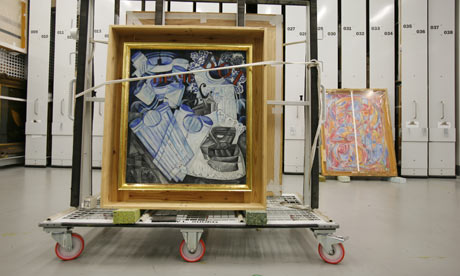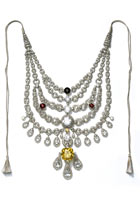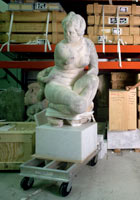
About to be safely stowed … Natalya Goncharova’s Linen at the Tate storage warehouse. Photograph: David Levene
A blockbuster exhibition often showcases an artist’s work or offers a new interpretation of an era, but it shows us only part of the story. Look closely at a label on the gallery wall and you’ll notice a little note saying “On loan from …”. The larger touring exhibitions read like a high-fashion social diary, galloping across the globe from New York to Paris, London to Tokyo, while smaller shows criss-cross their way from Pittsburgh to Bogotá, Figueres to Melbourne. Art travels around the world in myriad ways: in and out of galleries and auction houses, to and from private collections. The question is: how does it get there?
My journey begins at the Victoria and Albert Museum in London, where Anna Jackson, deputy keeper of the Asia department, has been delving into the royal collections of India’s maharajas over the last 18 months. She’s preparing for the museum’s autumn exhibition, Maharaja: The Splendour of India’s Royal Courts, which will open in October 2009. The original idea was floated more than two years ago, and the museum officially announced the show some months later. Jackson first set out for India in February 2008, to see what treasures the royal collections would yield.

Her enthusiasm for putting together the exhibition is infectious – Jackson is determined to go beyond the general history of the maharajas: “We tried to show [the keepers of the royal collections] that what we really wanted to do is tell the whole story about who these rulers were, why they were important and why their culture was so important.”
Bizzarely, perhaps, Jackson’s first stop wasn’t India but Geneva, where the legendary Patiala necklace, a ceremonial item commissioned by the Maharaja of Patalia in 1928 from the French jewellers Cartier, is housed in a high-security vault. Originally containing 2,930 diamonds (including the infamous, golf-ball size, yellow De Beers diamond), the necklace has been stolen, smuggled, sold and restored, long before it was ever entrusted to the V&A. Like a magpie fixated with a sparkling find, Jackson was determined to negotiate the necklace’s loan and exhibit it in Britain for the first time. “It’s such an iconic object for us,” she says – as “jewellery is such an important aspect of royal splendour.”
Only once the Cartier loan was approved did Jackson set off to visit the royal collections of Udaipur and Jodhpur. As word of the visit spread, she and a colleague gained access to previously unknown collections and made several trips, viewing hundreds of pieces, to select the final 50 – thrones, jewel-encrusted swords, even a Rolls-Royce ordered by the Crown Prince of Mewar in 1927.
There followed a labyrinthine series of paperwork to enable the works to travel. This meant persuading descendants to send their treasures out on loan – for the first time, in many cases. Negotiation is often the hardest part of putting together an exhibition – no payment is involved and the relationship between lender and receiver is based entirely on trust.
Some works, as Philip Rylands, director of the Peggy Guggenheim Collection in Venice explains, will never be loaned due to their fragility. Other factors that colour a decision to lend are the value of the proposed exhibition and whether the lender wants to borrow from the borrower in the future. “If you are going to be a borrower you have to be a lender, so some of it is obligatory,” he says. “It’s true that exhibitions can be very good for works of art. They can put works in a context, make people understand their position in an oeuvre of an artist.”
None of the people I spoke to could think of – or were willing to reveal – any incidents where art on the move had been damaged or lost. Tales of transit horror (crates left on runways, valuables dismantled en route, say) are either well-kept secrets or the stuff of urban myth.
In any case, prior to the objects being packed up, curators assess their condition and carry out any necessary work using local conservators – in the V&A’s case, the Indian Ministry of Culture offered to underwrite the expense, recognising that the exhibition would be telling its country’s history. Only after several parties have been involved in the sign-off can the transit – carefully – begin.

This is where global fine art movers such as New York-based Crozier Fine Arts come in. Formed by Bob Crozier in 1976, the company was originally set up to help his sculptor brother and friends move artworks between studios and galleries in New York. Since then, Crozier has held and transferred $6bn worth of art to museums, private collections and auctions. Some pieces have rested in his storage facilities for years, stored with the kind of discretion that keeps the company on speed dial for much of the art world.
The New York storage facility nestles alongside the city’s newest and hippest art galleries in the former meat-packing district of Chelsea. Stepping off the street through a nondescript doorway, the sweltering heat is offset by the cold floors; the art stored out of sight in windowless rooms. There are special rooms for artworks that are on sale. So secret is the process by which buyers view these works that code words are used instead of the real names of sellers and buyers. One viewing room, housing a Donald Judd sculpture, resembles a pristine, climate-controlled prison cell, all white walls and concrete flooring. Potential buyers file in to sit on the chair placed in front of the sculpture while they decide whether to bid or not.
It is a world in which confidentiality agreements abound – from the staff unpacking, stacking and loading the art to the movers themselves. If you’re expecting burly removal men you’d be wrong – all of Crozier’s employees have a background in the arts and many are artists.
At the head of it all, Crozier manoeuvres each step of the international journey. With a mixture of strict professionalism and caginess essential for his job, Crozier is unwilling to divulge the tiniest detail on the number of artworks shipped each week or the type of objects coming into the storage facility; the fear of art thieves, it seems, makes the journey of an artwork the most complex and closely guarded aspect of organising an exhibition.
The recession may have put holes in the schedules of many touring shows, but there’s little doubt as to what is driving much of this trade: the growth of the blockbuster exhibition. Curator Brendan Moore from the British Museum says that when he arrived 15 years ago, “the [museum] was doing a lot of international loans, but the increase in the level, the sheer volume of things, is phenomenal.”
Between 2002 and 2008, the number of touring international exhibitions drawn entirely from the British Museum’s own collections has increased by more than 100%, he says. The number of individual loans to international venues is up by about a quarter in the same period. Another factor is technology: climate-controlled trucks and new crating methods that keep air flowing and banish humidity have greatly improved the safety of objects in transit.
Rylands, however, believes there is “something remorseless” about exhibition programming. Jackson, of the V&A, outlines the pressure on museums: “You always have to think you are as good as your last show, you always have to do something more interesting.” But it is the blockbuster exhibition that has fostered this growth. “There is extraordinary enthusiasm and appetite for culture in whatever form,” Brendan Moore concurs.
More exhibitions equals more art on loan, which in turn means more art in transit from location to location under the strictest veil of secrecy. As Crozier explains it, the entire industry is based on a merry-go-round of “who’s got what and wants what”.
